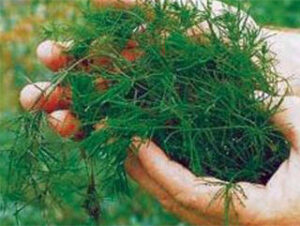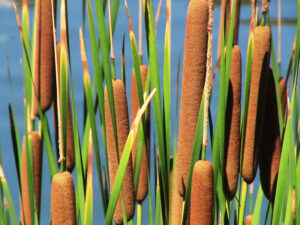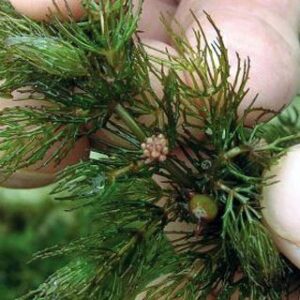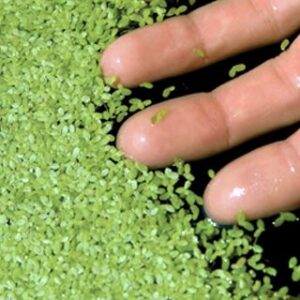Different types of aquatic vegetation
Weeds come in all shapes and sizes. Healthy Ponds breaks it down into 4 categories:
- Muskgrass/Chara
- Cattails
- Other Weeds – Sludge Bottom
- Other Weeds – Rocky Bottom
Muskgrass/Chara

Muskgrass
Muskgrass or Chara is often called skunkweed because of its foul odor. It is a common dark green algae with multiple branches. It’s crunchy in texture and is often confused with submerged flowering plants. However, muskgrass has no flower. Healthy Ponds Captain product effectively treats muskgrass.
Cattails

Cattails
Cattails are another common weed. They are easily identifiable by their brown sausage-shaped stem. Cattails can grow in water or boggy areas and reach heights up to 10 feet. When they overgrow, they choke off open water and drive away birds. Use Emerge from Healthy Ponds to tackle cattails.
Other Pondweed – Sludge or Rocky Bottom

Other Pondweed: Coontail
Pond sludge can go by a variety of names. But it’s typically an accumulation of decaying algae, plants, fish or waste at the bottom of a pond. If left unchecked, it will severely harm the oxygen level of your pond. Whether your pond has a sludge bottom or more of a rocky bottom, there are products to address each. Your pondweed problem may progress to the point that chemicals are required. Healthy Ponds has a number of algaecides specifically designed to work with our all-natural products. However, it’s important to know that chemicals knock organic matter to the bottom of your pond. You will eventually develop pondweed again as the matter you are treating starts to decay.

Other Pondweed: Duckweed
Still not sure what type of pondweed problem you’re experiencing? Check out our weed definitions page to learn more. Want an easy way to identify what product to use on which type of pondweed? Download our Products to Treat Pondweed Chart by clicking the link below. You can also view our Aquatic Vegetation Treatment Plan for treatment specific recommendations.
View Products to Treat Pondweed Chart
All-natural follow up is important
Chemicals work great for addressing initial pond problems. But it’s very important to break the chemical cycle and introduce a long-term, healthier solution. Once initial pondweed problems are addressed we strongly encourage the use of our all-natural 3-step process. Step one uses biodegradable dispensers to add beneficial bacteria to the water that consume and remove the excess nutrients that act as a food source for excess nutrients. Step two uses supplements to work in conjunction with dispensers. Supplements work by quickly increasing beneficial bacteria in the water. They also work in conjunction with our dispensers. Finally, step three is the dispersion of colorants. Colorants not only give the pond a great look, they also help to keep the pond temperature cooler.
Questions? Call customer service at 877-948-0303 or email support@bioverse.com


